Writing in “Flight Journal, famed Grumman test pilot Corky Meyer -
the last actual "airplane person" to head a major airplane company - named
the P-47 Thunderbolt the "best fighter of World War II - ETO."
As he pointed out, it had high performance, yet a
wartime-trained 200-hour pilot could fly it, with a well laid-out cockpit in
which all the controls, switches, and instruments were handily located. It
exceeded at three of the four performance parameters he established: air
combat capability, fighter escort capability, ground support capability and
photo-reconnaissance (it only missed on the latter).
With 15,683 Thunderbolts produced between 1941-45,
it is the most-produced American fighter ever.
Republic delivered one in 1941, 532 in 1942, 4,428
in 1943, 7,065 in 1944 and 3,657 in 1945. 730 were operated by the RAF in
Southeast Asia, while 446 flew for the French Air Force in Europe. The only
theater of war in which the Thunderbolt did not fight was in Alaska; it is
telling that the two top-scoring American fighter pilots in the ETO both
flew P-47s exclusively, and all 10 of the top P-47 aces in the ETO survived
the war. By D-Day there were 17 P-47 Fighter Groups stationed in England,
and in the next eleven months, they swept across western Europe like an
aerial scythe.
The P-47 Thunderbolt acquired its name "Jug" when the P-47D-25
series appeared on operations.
With the upper fuselage cut down to make way for a
teardrop-shaped "bubbletop" canopy, the fuselage took on the shape of a milk
bottle, hence "Jug."
It was later claimed the name came from the word
"Juggernaut," and in light of the career of the bubbletop Thunderbolts
across 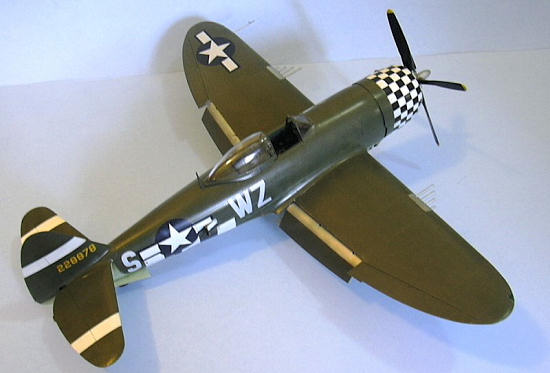 Western
Europe in the period between D-Day and V-E Day, that sounds reasonable.
But to Thunderbolt pilots who were there when the
"bubbletop" replaced the "razorback," "Jug" meant milk jug.
Western
Europe in the period between D-Day and V-E Day, that sounds reasonable.
But to Thunderbolt pilots who were there when the
"bubbletop" replaced the "razorback," "Jug" meant milk jug.
The first "bubbletop" Thunderbolt was the YP-47K, which began life
as a P-47D-11RE, and was the second fighter fitted with a "bubble" canopy
after the British Hawker Typhoon.
Originally scheduled for production as the P-47L,
the "super 'Bolt" as pilots called it originally began appearing in England
in May, 1944, under the designation P-47D-25RE. With an R-2800-59 or -63
engine putting out 2,300 h.p. under war emergency rating, and swinging a
Hamilton Standard Hydromatic propeller of 13 feet, 1 7/8 inches diameter,
the airplane had increased tankage and the ability to carry a 150-gallon
drop tank on the centerline shackles.
At first, only flight leaders - group commanders and
squadron commanders - received the new airplane. By the end of the summer of
1944, with the high losses sustained in ground attack missions during the
Battle of Normandy, the "bubbletop" P-47D-25, -26, -27 and -28 Thunderbolts
from Farmingdale (RE) and Evansville (RA) were the standard fighter bomber
of the U.S. 9th Army Air Force.
The 78th
Fighter Group:
Established on February 9, 1942 at Baer Field, Indiana, the 78th
Fighter Group was originally the third USAAF fighter group to equip with the
P-38.
The 78th
established itself in England in mid-November 1942, as part of the plan to
use the P-38 as the standard long-range escort fighter for the 8th
Air Force.
This plan was disrupted by Operation Torch, the invasion of
North Africa.
The 1st
and 14th Fighter Groups - which
had arrived in England over the summer and early fall of 1942 - transferred
to the 12th Air Force to
participate in the North African campaign, and many of the qualified P-38
pilots and all of the available P-38s operated by the 78th
FG were transferred to these two units to make up for combat attrition as a
result of North African combat.
Lacking P-38s and trained pilots, the 78th
remained in England and was equipped with P-47s, joining the 4th
Fighter Group and the 56th
Fighter Group as the original units of 8th
Fighter Command.
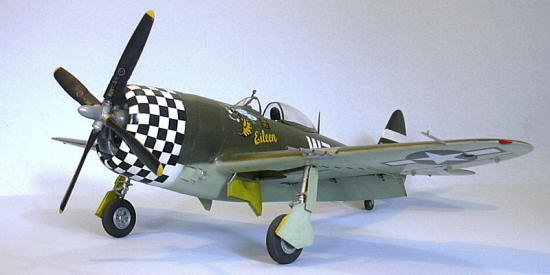 Along with the 4th and
56th, the 78th
began operations in late March 1943.
At that point, the P-47 could barely fly to the
Dutch coast and was laughable as a long-range escort, given it had
originally been designed as a high-altitude short range interceptor.
Over the course of the summer of 1943, the P-47
units managed to develop a long-range escort capability through the use of
ever-larger and ever more numerous drop tanks, the groups were eventually
able to make it as far as Dummer Lake by the end of 1943.
Along with the 4th and
56th, the 78th
began operations in late March 1943.
At that point, the P-47 could barely fly to the
Dutch coast and was laughable as a long-range escort, given it had
originally been designed as a high-altitude short range interceptor.
Over the course of the summer of 1943, the P-47
units managed to develop a long-range escort capability through the use of
ever-larger and ever more numerous drop tanks, the groups were eventually
able to make it as far as Dummer Lake by the end of 1943.
Over the spring and summer of 1943, the 78th
began scoring against the Luftwaffe. The first “triple kill” was scored by
MAJ Eugene Roberts, CO of the 84th
FS on June 30, 1943, while CAPT Charles London became the first 8th
AF “ace” when he scored a double on the same mission and the group returned
to Duxford with a total of 16 victories, the highest score to date for an 8th
AF unit. Another first was scored on this mission, when 1st
Lt Quince Brown came home “on the deck” after evading a German attack and
shot up an enemy locomotive he encountered west of Rotterdam; this was the
first of many German locomotives that would be destroyed by P-47s in the
next two years. On August 28, 1944, the 78th
claimed the first Me-262 shot down by the 8th
Air Force.
As the 8th Air Force
transferred to the P-41 in 1944, the Thunderbolt-equipped groups found
themselves frequently involved in support of ground operations on the
Continent.
The 56th and 78th
Groups were tasked with providing fighter escort to the troop transports for
the airborne operation known as Operation Market Garden, and gave close air
support to the American 82nd
and 101st Airborne Division and
the British 6th Airborne.
The 78th Fighter Group
transitioned to the P-51 Mustang in December 1944, leaving the 56th
Fighter Group as the last 8th
Air Force unit still using the Thunderbolt, and giving the 78th
FG the distinction of being the only fighter group in the USAAF to fly the
P-38, P-47 and P-51.
The first injection-molded 1/32 P-47d was released by Revell 30
years ago.
As with many kits from that era, it suffered from various
inaccuracies, several of which - like the incorrectly-shaped vertical fin
and rudder - were not easily fixable.
While Jerry Rutman released an accurate 1/32 P-47D
in resin during the 1990s, until the arrival of this kit from Hasegawa, that
Revell kit was it for mainstream modeling.
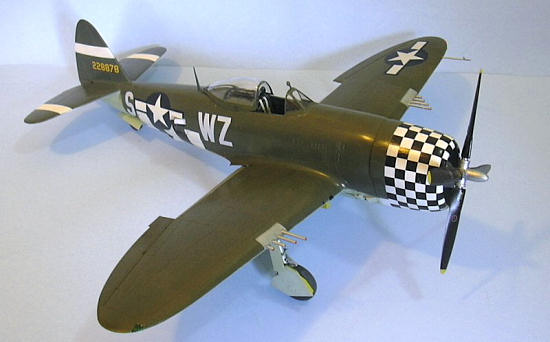 This Hasegawa kit effectively makes the Revell kit irrelevant.
When this kit was announced, many modelers were
afraid that Hasegawa would merely scale up their 1/48 kit, which suffered
from its own unfixably-wrong errors.
There is no need to worry.
This kit is far closer to being a 1/32 scale-up of
the highly-accurate Tamiya P-47D than to anything else from Hasegawa.
This Hasegawa kit effectively makes the Revell kit irrelevant.
When this kit was announced, many modelers were
afraid that Hasegawa would merely scale up their 1/48 kit, which suffered
from its own unfixably-wrong errors.
There is no need to worry.
This kit is far closer to being a 1/32 scale-up of
the highly-accurate Tamiya P-47D than to anything else from Hasegawa.
Out of the box, the kit makes up most accurately as a P-47D-27 or
later Thunderbolt, due to the fact that the cockpit provides only the smooth
floor associated with later Thunderbolts.
The kit provides both the hydraulic
Hamilton-Standard prop used by the P-47D-25/26 and the Curtiss-Electric
symmetrical paddle prop used by the P-47D-27 and later.
If a modeler elects to use the later gunsight and
the extended vertical fin part that are both provided but listed as “not to
be used,” the kit can be turned into any bubbletop P-47D up to the P-47D-40.
A modeler who obtains Jerry Rutman’s resin
asymmetrical prop, it will be possible to construct a P-47M.
The kit has separate flaps, which can be posed up or down.
In my experience, posable flaps are best displayed
down, since fit to the wing can be problematic.
Hasegawa dealt with the problem of having release pin molds inside
the gear doors by the very nice expedient of having the gear doors come in
inner and outer parts, with the release marks on the inside of both parts.
 The wing pylons are separate.
Surprisingly, the kit does not provide the more
common (at least in the ETO) 108-gallon paper tanks, but does provide the
150-gallon “flat tank” for the centerline and the later “P-38 style” tanks
used outside the ETO.
Underwing armament also includes two 500-lob bombs.
The wing pylons are separate.
Surprisingly, the kit does not provide the more
common (at least in the ETO) 108-gallon paper tanks, but does provide the
150-gallon “flat tank” for the centerline and the later “P-38 style” tanks
used outside the ETO.
Underwing armament also includes two 500-lob bombs.
A very well-molded pilot figure is provided, whose face looks
strikingly like Gabreski’s.
The only complaint I can find about the kit overall is that there
are several long sink marks on the upper and lower wing halves, where there
is internal detail.
This is similar to what one finds on the 1/32 Bf-109
wings and Fw-190 wings, and is easily dealt with using Mr. Surfacer 500 and
a few minutes with a sanding stick.
Polish will have to be applied if a natural metal
surface is going to be created.
I first painted all the interior detail parts before further
assembly.
The wheel wells and gear door interiors were painted “Yellow
Zinc Chromate” which I created by mixing Tamiya Flat Black and Flat Yellow
(the way real Zinc Chromate is created).
The interior of the cowling and the various turbo
intakes were painted Tamiya flat Aluminum, while the pistons were painted
with Tamiya “Titanium Silver.”
The cockpit was painted Tamiya Dark Green.
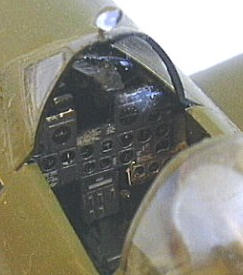 I used the Eduard photo-etch detail set for the cockpit, which
provides instrument panels and other detail bits, and a set of seatbelts
that look very accurate when completed.
I used the Eduard photo-etch detail set for the cockpit, which
provides instrument panels and other detail bits, and a set of seatbelts
that look very accurate when completed.
As with all the new Hasegawa 1/32 kits, the Thunderbolt is very
well-designed and a breeze to build.
That is, it’s a breeze to build if you recognize at
the outset that the parts fit very precisely.
If you are particularly careful to cut off all
vestiges of any sprue gates, and test fit everything, you can assemble this
kit with a minimum of any kind of gap-filler.
I only used Mr. Surfacer on the centerline seam
along the lower fuselage and on the upper fuselage behind the cockpit, and
both areas could have been perfectly okay with a light sanding.
I had one area of difficulty, and that was in assembling the engine
cowling and then attaching the engine and cowling to the rest of the model
with a completely accurate fit. If you do not test-fit the attachment of the
engine to the forward fuselage, the result is a very noticeable “step” on
the lower area of the cowling/fuselage joint.
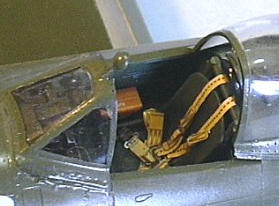 The solution is to widen the hole on the rear engine
bulkhead, so that the engine and cowling attach correctly.
I personally think that the four-part cowling is at
least as “fiddly” as the DML Fw-190A cowlings, so there is a lot of
opportunity here for “operator error.”
The solution is to widen the hole on the rear engine
bulkhead, so that the engine and cowling attach correctly.
I personally think that the four-part cowling is at
least as “fiddly” as the DML Fw-190A cowlings, so there is a lot of
opportunity here for “operator error.”
The spars insure that no one is going to misalign the wings on this
kit.
I had decided to assemble the flaps down, and so left them off until
after the model was painted.
One problem is that there is a considerable mold
deformity on the upper wings over the area of the flap forward bulkhead,
which needs to be filled with cyanoacrylate glue and sanded smooth.
Since I was building a P-47D-28RE, I used the gunsight part that is
listed in the parts diagram as “do not use.”
I also made sure to use the underwing inserts with
the dive flaps and the landing light in the outboard position.
Painting:
I have long thought that the P-47s flown by the 78th
FG in the late summer and fall of 1944 were among the best-looking 8th
Air 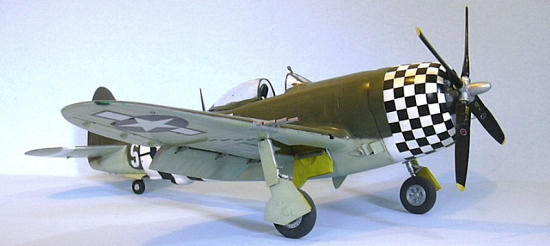 Force
P-47s.
The airplanes were painted with RAF Dark Green upper surfaces
and Sky lower surfaces.
While many 8th
AF units got rid of the “D-Day” stripes, the 78th
kept them on the lower fuselage, since the unit flew so many missions in
support of ground troops where ease of identification was paramount.
Force
P-47s.
The airplanes were painted with RAF Dark Green upper surfaces
and Sky lower surfaces.
While many 8th
AF units got rid of the “D-Day” stripes, the 78th
kept them on the lower fuselage, since the unit flew so many missions in
support of ground troops where ease of identification was paramount.
After painting the engine cowling and the ID stripes on the tail
surfaces white and masking them off, I then did the D-Day stripes and masked
them off, then used Xtracrylix “RAF Sky” and “RAF Dark Green” for the
camouflage.
It is important to note that while Thunderbolts that came
painted in camouflage from the factory had the entire flap painted in the
camouflage colors, those airplanes that were painted “in the field” - as
were all those used by the 78th
FG - had the forward area of the flaps in natural metal, along with the
interior of the flap area of the wing.
I painted these areas with Tamiya “Flat Aluminum.”
Decals:
I used the now out-of-production Cutting Edge decal sheet to do 1st
Lt, Frank Oiler’s well-known “Eileen”.
The decals went down without problem.
When it comes time to attach the landing gear, the design here is
such that no one can misalign the gear leg, since the tab is set at the
correct angles - once in place, the gear is at the correct angles.
I then attached the flaps, and used the Curtiss
“symmetrical” paddle prop.
With the canopy and windshield unmasked and the
canopy positioned open, the model was complete.
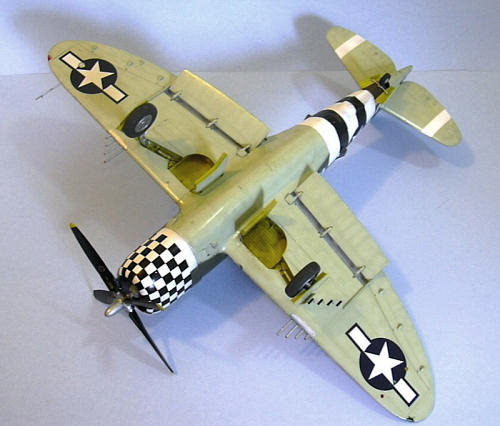 Hasegawa’s Thunderbolt can join the Tamiya kit as the most accurate
P-47 kits available (which is unsurprising since it is obvious Hasegawa did
their “due diligence” in examining the design of the Tamiya kit).
If I wasn’t already a fan of 1/32 modeling, this kit
would be the “tipping point.”
If you have yet to do a 1/32 model, this is the kit
to start with.
The production design is such that it will almost be
“foolproof” in assembly as regards getting the various alignment issues
right (I’d almost say “completely fool-proof,” other than for the potential
problem of attaching the engine and cowling to the fuselage).
This should become one of the most popular 1/32 kits
released.
It is excellent value for the money and highly recommended.
Hasegawa’s Thunderbolt can join the Tamiya kit as the most accurate
P-47 kits available (which is unsurprising since it is obvious Hasegawa did
their “due diligence” in examining the design of the Tamiya kit).
If I wasn’t already a fan of 1/32 modeling, this kit
would be the “tipping point.”
If you have yet to do a 1/32 model, this is the kit
to start with.
The production design is such that it will almost be
“foolproof” in assembly as regards getting the various alignment issues
right (I’d almost say “completely fool-proof,” other than for the potential
problem of attaching the engine and cowling to the fuselage).
This should become one of the most popular 1/32 kits
released.
It is excellent value for the money and highly recommended.
Review kit courtesy
of HobbyLink Japan. Get yours at “Japanese prices” at
www.hlj.com
Tom
Cleaver
September 2008
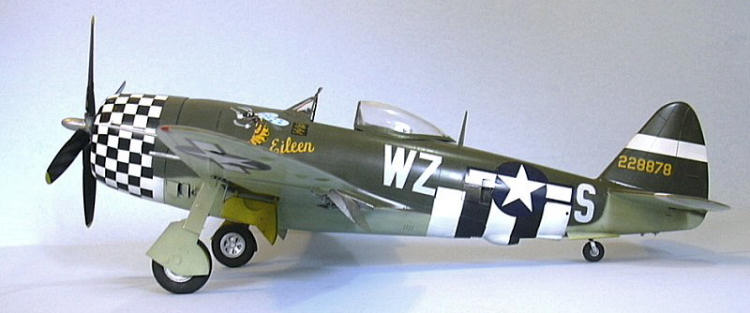

 Western
Europe in the period between D-Day and V-E Day, that sounds reasonable.
But to Thunderbolt pilots who were there when the
"bubbletop" replaced the "razorback," "Jug" meant milk jug.
Western
Europe in the period between D-Day and V-E Day, that sounds reasonable.
But to Thunderbolt pilots who were there when the
"bubbletop" replaced the "razorback," "Jug" meant milk jug.



 The solution is to widen the hole on the rear engine
bulkhead, so that the engine and cowling attach correctly.
I personally think that the four-part cowling is at
least as “fiddly” as the DML Fw-190A cowlings, so there is a lot of
opportunity here for “operator error.”
The solution is to widen the hole on the rear engine
bulkhead, so that the engine and cowling attach correctly.
I personally think that the four-part cowling is at
least as “fiddly” as the DML Fw-190A cowlings, so there is a lot of
opportunity here for “operator error.” Force
P-47s.
The airplanes were painted with RAF Dark Green upper surfaces
and Sky lower surfaces.
While many 8th
AF units got rid of the “D-Day” stripes, the 78th
kept them on the lower fuselage, since the unit flew so many missions in
support of ground troops where ease of identification was paramount.
Force
P-47s.
The airplanes were painted with RAF Dark Green upper surfaces
and Sky lower surfaces.
While many 8th
AF units got rid of the “D-Day” stripes, the 78th
kept them on the lower fuselage, since the unit flew so many missions in
support of ground troops where ease of identification was paramount.